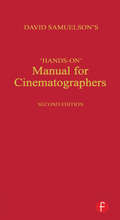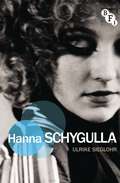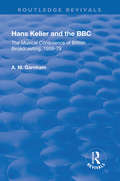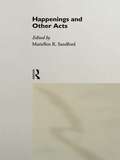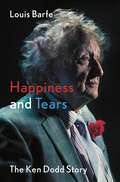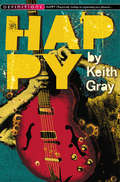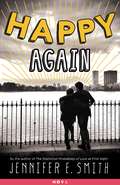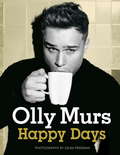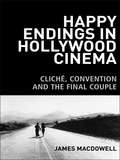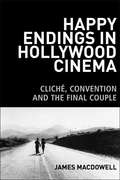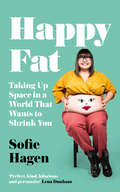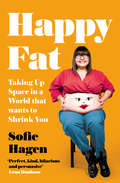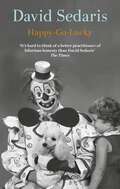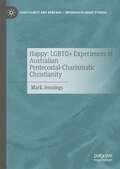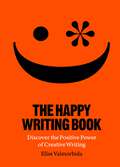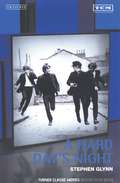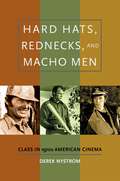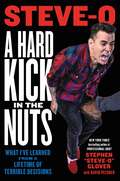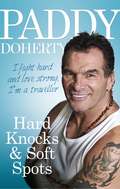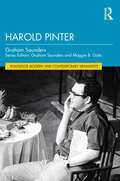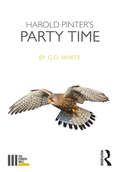- Table View
- List View
Hands-on Manual for Cinematographers
by David SamuelsonThe "Hands On" Manual for Cinematographers contains a wealth of information, theory, diagrams and tables on all aspects of cinematography. Widely recognised as the "Cinematographer's Bible" the book is organised in a unique manner for easy reference on location, and remains an essential component of the cameraman's box. Everything you need to know about cinematography can be found in this book - from camera choice, maintenance and threading diagrams; to electricity on location, equipment checklists, film stock, lenses, light and colour. Of particular use will be the mathematics, formulae, look up tables and step by step examples used for everything from imperial/metric conversions to electricity, exposure, film length, running times, lights and optics. Sections on special effects and utilities are also included as well as a list of useful websites.David Samuelson is a well known and respected cameraman who has been instrumental in fostering award winning new technical innovations. He is a technical consultant, lecturer and author of three other leading publications for Focal Press: The Panaflex User's Manual 2ED, Motion Picture Camera and Lighting Equipment and Motion Picture Camera Techniques.
Hanna Schygulla (Film Stars)
by Ulrike SieglohrOne of the most celebrated figures of the New German Cinema, Hanna Schygulla acquired transnational stardom through her work with a range of directors in different national cinemas and languages.This absorbing study charts Schygulla's career and star persona from her early days as a member of Rainer Werner Fassbinder's experimental anti-teater group to her work with eminent European auteurs, including Jean-Luc Godard, Andrzej Wajda and, more recently, Fatih Akin. It also discusses her reinvention as an acclaimed cabaret chanteuse. Unpicking the myth that Schygulla's star persona depended on her collaboration with Fassbinder, Ulrike Sieglohr examines how her versatile and idiosyncratic acting style developed throughout her career. With in-depth analysis of key films and their international receptions, Sieglohr foregrounds Schygulla's individual agency, resourcefulness and talent.
Hans Keller and the BBC: The Musical Conscience of British Broadcasting 1959-1979
by A. M. GarnhamOriginally published in 2003, Hans Keller and the BBC is a vivid portrait of the changing face of British broadcasting seen through the work of one of its most significant personalities. Starting with an examination of Keller’s early psychological interests, and the evolution of his method of ‘functional analysis’ of music (with which the BBC was intimately concerned), the book charts the huge contribution Keller made to British music during his BBC years. Also explored in detail are the successive crises of the Third Programme and its replacement by Radio 3, together with Keller’s leading role in opposing the decline of the BBC’s cultural idealism. Drawing on a wealth of primary sources, much of which has never been previously examined, this study paints a striking picture of Keller’s personality in combination with the BBC’s turbulent inner workings, showing the effect of one remarkable individual on the most powerful musical institution in 20th-century Britain.
Hans Keller and the BBC: The Musical Conscience of British Broadcasting 1959-1979
by A. M. GarnhamOriginally published in 2003, Hans Keller and the BBC is a vivid portrait of the changing face of British broadcasting seen through the work of one of its most significant personalities. Starting with an examination of Keller’s early psychological interests, and the evolution of his method of ‘functional analysis’ of music (with which the BBC was intimately concerned), the book charts the huge contribution Keller made to British music during his BBC years. Also explored in detail are the successive crises of the Third Programme and its replacement by Radio 3, together with Keller’s leading role in opposing the decline of the BBC’s cultural idealism. Drawing on a wealth of primary sources, much of which has never been previously examined, this study paints a striking picture of Keller’s personality in combination with the BBC’s turbulent inner workings, showing the effect of one remarkable individual on the most powerful musical institution in 20th-century Britain.
Happenings and Other Acts (Worlds of Performance)
by Mariellen SandfordFirst published in 2004. Routledge is an imprint of Taylor & Francis, an informa company.
Happenings and Other Acts (Worlds of Performance)
by Mariellen R. SandfordFirst published in 2004. Routledge is an imprint of Taylor & Francis, an informa company.
Happiness and Tears: The Ken Dodd Story
by Louis Barfe'I suffer from acute kleptomania. But when it gets bad, I take something for it.' Ken Dodd was a legend of British comedy. He launched his career in 1954, adopted his trademark 'tickling stick' two years later and went on to enjoy a sixty-year career as the nation's jester. Dodd's act was frenzied and zany, exploiting his saucer-eyed, buck-toothed appearance and deploying a repertoire of one-liners, whimsical and verbal inventions and liberal doses of saucy – but never dirty – jokes. Louis Barfe charts Dodd's life and extraordinarily long career, revealing him to be the last of the great variety acts – and a comic phenomenon who delighted his audiences across seven decades. Reviews for Happiness and Tears: 'The definitive account' The Times. 'An industriously thorough, entertaining biography' The Spectator. 'Sure to delight Dodd's many admirers' TLS. 'Fascinatingly odd' Daily Express. 'An absolute joy' Choice.
Happy (Definitions Ser.)
by Keith Gray'Hundreds of people want to be in a band. They all get guitars and they all play gigs and they all write songs, and they still never make it.'There's a big difference between being a rock star and a pop idol - Will and Danny know which they'd prefer to be. They form the group Happy and it seems they are on the way to realising their ambitions. But when Happy's first gig is cut short by a fire at the venue, Will struggles to cope with his bitter disappointment and retreats into his private world, rejecting everyone around him. His girlfriend, Beth turns to Danny for comfort and their friendship soon becomes something more. With nothing left for him at home, Will leaves for London to stay with his session-musician father and to follow his dream.
Happy Again
by Jennifer E. SmithEllie O'Neill and Graham Larkin fell hard for each other when a misspelled email address unexpectedly brought them together. Now, over a year has passed since they said goodbye with the promise to stay in touch, and their daily emails have dwindled to nothing. Ellie is a freshman in college and has told herself to move on, and Graham has kept himself busy starring in more movies, as well as a few tabloid columns. But fate brought these two together once before--and it isn't done with them yet. In this sequel novella to This is What Happy Looks Like, Jennifer E. Smith revisits two beloved characters to tell the story of one magical night in Manhattan. When Ellie and Graham come face to face once more, can they get past the months of silence and the hurt feelings to find their happily-ever-after again? Word Count: ~18,000
Happy Days: Official illustrated autobiography
by Olly MursOlly Murs invites you behind the scenes in his official illustrated autobiography filled with hundreds of brand new and exclusive photos. 'My life has been a non-stop roller-coaster of extreme emotions, crazy days, unexpected highs and yet my life hasn't been without its low points too. I've tried to imagine myself sitting down with you explaining what I was thinking and feeling during those times. I hope this book will give you a behind-the-scenes view of my journey into a place where I finally found what had been missing in my life for all those years: music.' Endearingly written with disarming honesty and filled with exclusive new and unseen photographs on and offstage, Happy Days takes you closer to Olly than you've ever been before.
Happy Endings in Hollywood Cinema: Cliche, Convention and the Final Couple
by James MacDowell"Hollywood ‘happy ending’ has long been considered among the most famous and standardised features in the whole of narrative filmmaking. Yet, while ceaselessly invoked, this notorious device has received barely any detailed attention from the field of film studies. This book is thus the first in-depth examination of one of the most overused and under-analysed concepts in discussions of popular cinema. What exactly is the 'happy ending'? Is it simply a cliché, as commonly supposed? Why has it earned such an unenviable reputation? What does it, or can it, mean? Concentrating especially on conclusions featuring an ultimate romantic union – the final couple – this wide-ranging investigation probes traditional associations between the 'happy ending' and homogeneity, closure, ‘unrealism’, and ideological conservatism, testing widespread assumptions against the evidence offered by a range of classical and contemporary films. "
Happy Endings in Hollywood Cinema: Cliche, Convention and the Final Couple (Edinburgh University Press)
by James MacDowellThe Hollywood ‘happy ending’ has long been considered among the most famous and standardised features in the whole of narrative filmmaking. Yet, while ceaselessly invoked, this notorious device has received barely any detailed attention from the field of film studies. This book is thus the first in-depth examination of one of the most overused and under-analysed concepts in discussions of popular cinema. What exactly is the 'happy ending'? Is it simply a cliché, as commonly supposed? Why has it earned such an unenviable reputation? What does it, or can it, mean? Concentrating especially on conclusions featuring an ultimate romantic union †“ the final couple †“ this wide-ranging investigation probes traditional associations between the 'happy ending' and homogeneity, closure, ‘unrealism’, and ideological conservatism, testing widespread assumptions against the evidence offered by a range of classical and contemporary films. Key Features: Defines key features of the Hollywood ‘happy ending’ through detailed textual analysis and theoretical debate. Traces the historical development of the scholarly approaches taken towards the cinematic ‘happy ending’ Reassesses the concept of cinematic closure and its relationship to genre, ideology and ‘unrealism’
Happy Fat: Taking Up Space In A World That Wants To Shrink You
by Sofie Hagen‘You need this book. Your mom needs this book. Your best friend needs this book. Everyone needs a dose of Happy Fat!’ Julie Murphy ‘I am a fat person and I love my body. I feel lucky to be able to say that – it has taken a lot of work and a lot of time.
Happy Fat: Taking Up Space In A World That Wants To Shrink You
by Sofie Hagen‘Perfect, kind, hilarious and persuasive’ Lena Dunham ‘You need this book. Your mum needs this book. Your best friend needs this book. Everyone needs a dose of Happy Fat!’ Julie Murphy
Happy-Go-Lucky
by David SedarisBack when restaurant menus were still printed on paper, and wearing a mask-or not-was a decision made mostly on Halloween, David Sedaris spent his time doing normal things. As Happy-Go-Lucky opens, he is learning to shoot guns with his sister, visiting muddy flea markets in Serbia, buying gummy worms to feed to ants, and telling his nonagenarian father wheelchair jokes. But then the pandemic hits, and like so many others, he's stuck in lockdown, unable to tour and read for audiences, the part of his work he loves most. To cope, he walks for miles through a nearly deserted city, smelling only his own breath. He vacuums his apartment twice a day, fails to hoard anything, and contemplates how sex workers and acupuncturists might be getting by during quarantine. As the world gradually settles into a new reality, Sedaris too finds himself changed. His offer to fix a stranger's teeth rebuffed, he straightens his own, and ventures into the world with new confidence. Newly orphaned, he considers what it means, in his seventh decade, no longer to be someone's son. And back on the road, he discovers a battle-scarred America: people weary, storefronts empty or festooned with Help Wanted signs, walls painted with graffiti reflecting the contradictory messages of our time: Eat the Rich. Trump 2024. Black Lives Matter. In Happy-Go-Lucky, David Sedaris once again captures what is most unexpected, hilarious, and poignant about these recent upheavals, personal and public, and expresses in precise language both the misanthropy and desire for connection that drive us all. If we must live in interesting times, there is no one better to chronicle them than the incomparable David Sedaris.Praise for Calypso'Sedaris is the premier observer of our world and its weirdnesses' Adam Kay, author of This is Going to Hurt'He's like an American Alan Bennett' Guardian'Unquestionably the king of comic writing . . . Calypso is both funnier and more heartbreaking than pretty much anything out there' Hadley Freeman, Guardian
Happy: LGBTQ+ Experiences of Australian Pentecostal-Charismatic Christianity (Christianity and Renewal - Interdisciplinary Studies)
by Mark JenningsThis book relates the unique experiences of Lesbian, Gay, Bisexual, Transgender and Queer/Questioning (LGBTQ+) people in Australian Pentecostal-Charismatic Christian churches. Grounded in the theoretical contributions of Michel Foucault, Judith Butler, Lewis Coser, and others, the book exposes the discursive ‘battleground’ over the ‘truth’ of sex which underlies the participants’ stories. These rich and complex narratives reveal the stakes of this conflict, manifested in ‘the line’ – a barrier restricting out LGBTQ+ people from full participation in ministry and service. Although some participants related stories of supportive—if typically conservative—congregations where they felt able to live out an authentic, integrated faith, others found they could only leave their formerly close and supportive communities behind, ‘counter-rejecting’ the churches and often the faith that they felt had rejected them.
The Happy Writing Book: Discover the Positive Power of Creative Writing
by Elise Valmorbida'There are many guides to good writing but none as valuable as this.' Oliver Kamm, author and columnist for The TimesCreative writing can enhance wellbeing, which can enhance creative writing, which can enhance wellbeing ... Become a better writer with over 100 inspiring prompts, insights and exercises specially devised by an award-winning author and creative writing teacher. Discover how the practice of creative writing - being expressive, exploring ideas, crafting words, shaping stories - can also deepen your appreciation of life.
A Hard Day's Night: Turner Classic Movies British Film Guide (British Film Guides)
by Stephen GlynnDubbed 'the Citizen Kane of juke-box movies', voted among the top 100 British films of all time, accorded a high-profile release on DVD, A Hard Day's Night, the Beatles' film debut of 1964, has proven to be that rare event – an exploitation 'quickie' that has firmly entered the cultural canon.A Hard Day's Night was shot, edited and distributed in a matter of weeks early in 1964 to cash in on a passing local fad. Yet by the time of its release the Beatles had conquered America, and their film debut was instantly recognised as a major movie phenomenon. Placing the film in its social context, Stephen Glynn relates it to other examples of the genre, discusses its frantic making and its euphoric critical and popular reception. He analyses the film in depth, highlighting the 'revolt' in its depiction of youth, class and sexuality, and the style in director Richard Lester's Pop Art visual correlation to the myth-making soundtrack of Beatlemania.Essential reading for students of film, fans of popular music and the fab four and those interested in the Sixties, Glynn's guide also explores the legacy of A Hard Day's Night from the Monkees through to MTV and beyond.
Hard Hats, Rednecks, and Macho Men: Class in 1970s American Cinema
by Derek NystromEverywhere you look in 1970s American cinema, you find white working-class men. They bring a violent conclusion to Easy Rider, murdering the film's representatives of countercultural alienation and disaffection. They lurk in the Georgia woods of Deliverance, attacking outsiders in a manner that evokes the South's recent history of racial violence and upheaval. They haunt the singles nightclubs of Looking for Mr. Goodbar, threatening the film's newly liberated heroine with patriarchal violence. They strut through the disco clubs of Saturday Night Fever, dancing to music whose roots in post-Stonewall homosexuality invite ambiguity that the men ignore. Hard Hats, Rednecks, and Macho Men argues that the persistent appearance of working-class characters in these and other films of the 1970s reveals the powerful role class played in the key social and political developments of the decade, such as the decline of the New Left and counterculture, the re-emergence of the South as the Sunbelt, and the rise of the women's and gay liberation movements. Examining the "youth cult" film, the neo-Western "southern," and the "new nightlife" film, Nystrom shows how these cinematic renderings of white working-class masculinity actually tell us more about the crises facing the middle class during the 1970s than about working-class experience itself. Hard Hats thus demonstrates how these representations of the working class serve as fantasies about a class Other-fantasies that offer imaginary resolutions to middle-class anxieties provoked by the decade's upheavals. Drawing on examples of iconic films from the era-Saturday Night Fever, Cruising, Five Easy Pieces, and Walking Tall, among others-Nystrom presents an incisive, evocative study of class and American cinema during one of the nation's most tumultuous decades.
A Hard Kick in the Nuts: What I've Learned from a Lifetime of Terrible Decisions
by Stephen Steve-O GloverStephen "Steve-O" Glover—social media icon, comedy-touring stalwart, and star of Jackass—delivers a hilarious and practical guide to recovery, relationships, career, and how to keep thriving long after you should be dead. Steve-O is best known for his wildly dangerous, foolish, painful, embarrassing, and sometimes death-defying stunts. At age 48, however, he faces his greatest challenge yet: getting older. A Hard Kick in the Nuts: What I&’ve Learned from a Lifetime of Terrible Decisions is a captivating exploration of life and how to live it by an individual who has already lived way more than a lifetime&’s worth of extreme experiences. Steve-O grapples with the right balance between maturity and staying true to yourself, not repeating your &“greatest hits,&” maintaining sobriety and a healthy regimen, avoiding selfishness, and finding the right partner for life. Having built a gargantuan and loyal social media following while establishing a successful stand-up career—all after a couple of decades of dubious behavior—Steve-O is proof that anyone can find meaning and fulfillment in life, no matter what path they choose. Packed with self-deprecating wit and gruelingly earned wisdom, A Hard Kick in the Nuts will reverberate with readers everywhere who have lived a lot (sometimes too much) and are now wondering how to approach the years to come. Or maybe just need some good motivation to get out of bed tomorrow. One of many tips: Be your own harshest critic, then cut yourself a break, and enjoy this book.
Hard Knocks & Soft Spots
by Paddy Doherty'I fight hard and love strong. I'm a traveller.'Paddy Doherty loves his life as an Irish traveller, but as a child he felt like an outsider. He was different to his siblings. On the rare occasions he went to school, he was bullied for being a gypsy boy. And beyond the gates of the camp he found nothing but hostility. Slowly, Paddy's hurt turned into anger and by the age of 11 he had started out on an illustrious career in bare-knuckle fighting. This earned him a position as one of the most well-respected (and feared) men in the travelling community. Yet while he won countless contests in the ring, the real battles he faced were very much outside.In this deeply honest autobiography, he tells of how he has loved and lost five children; plummeted to seven stone while battling depression, drink and drugs. He describes how it feels to be shot point-blank in the head and the lengths he'll go to to protect his people, as well as life since My Big Fat Gypsy Wedding and Big Brother.Told with all the warmth and humour he is famed for, Paddy's rich and colourful story is one that will stay with you for a long time to come.
Harold Pinter (Routledge Modern and Contemporary Dramatists)
by Graham SaundersHarold Pinter provides an up-to-date analysis and reappraisal concerning the work of one of the most studied and performed dramatists in the world. Drawing extensively from The Harold Pinter Archive at the British Library as well as reviews and other critical materials, this book offers new insights into previously established views about his work. The book also analyses and reappraises specific key historical and contemporary productions, including a selection of Pinter’s most significant screenplays. In particular, this volume seeks to assess Pinter’s critical reputation and legacy since his death in 2008. These include his position as a political writer and political activist – from disassociation and neutrality on the subject until relatively late in his career when his drama sought to explicitly address questions of political dissent and torture by totalitarian regimes. The book revisits some familiar territories such as Pinter’s place as a British absurdist and the role memory plays in his work, but it also sets out to explore new territories such as Pinter’s changing attitudes towards gender in the light of #MeToo and queer politics and how in particular a play such as The Caretaker (1960) through several key productions has brought the issues of race into sharper focus. Part of the Routledge Modern and Contemporary Dramatist series, Harold Pinter provides an essential and accessible guide to the dramatists’ work.
Harold Pinter (Routledge Modern and Contemporary Dramatists)
by Graham SaundersHarold Pinter provides an up-to-date analysis and reappraisal concerning the work of one of the most studied and performed dramatists in the world. Drawing extensively from The Harold Pinter Archive at the British Library as well as reviews and other critical materials, this book offers new insights into previously established views about his work. The book also analyses and reappraises specific key historical and contemporary productions, including a selection of Pinter’s most significant screenplays. In particular, this volume seeks to assess Pinter’s critical reputation and legacy since his death in 2008. These include his position as a political writer and political activist – from disassociation and neutrality on the subject until relatively late in his career when his drama sought to explicitly address questions of political dissent and torture by totalitarian regimes. The book revisits some familiar territories such as Pinter’s place as a British absurdist and the role memory plays in his work, but it also sets out to explore new territories such as Pinter’s changing attitudes towards gender in the light of #MeToo and queer politics and how in particular a play such as The Caretaker (1960) through several key productions has brought the issues of race into sharper focus. Part of the Routledge Modern and Contemporary Dramatist series, Harold Pinter provides an essential and accessible guide to the dramatists’ work.
Harold Pinter's Party Time (The Fourth Wall)
by White G. D.‘All you have do is shut up and enjoy the hospitality.’ Terry Harold Pinter’s Party Time (1991) is an extraordinary distillation of the playwright’s key concerns. Pulsing with political anger, it marks a stepping stone on Pinter’s path from iconic dramatist of existential unease to Nobel Prize-winning poet of human rights. G. D. White situates this underrated play within a recognisably ‘Pinteresque’ landscape of ambiguous, brittle social drama while also recognising its particularity: Party Time is haunted by Augusto Pinochet’s right-wing coup against Salvador Allende’s democratically elected government in Chile. This book considers Party Time and its confederate plays in the dual context of Pinter’s literary career and burgeoning international concern with human rights and freedom of expression, contrasting his uneasy relationship with the UK’s powerful elite with the worldwide acclaim for his dramatic eviscerations of power.
Harold Pinter's Party Time (The Fourth Wall)
by White G. D.‘All you have do is shut up and enjoy the hospitality.’ Terry Harold Pinter’s Party Time (1991) is an extraordinary distillation of the playwright’s key concerns. Pulsing with political anger, it marks a stepping stone on Pinter’s path from iconic dramatist of existential unease to Nobel Prize-winning poet of human rights. G. D. White situates this underrated play within a recognisably ‘Pinteresque’ landscape of ambiguous, brittle social drama while also recognising its particularity: Party Time is haunted by Augusto Pinochet’s right-wing coup against Salvador Allende’s democratically elected government in Chile. This book considers Party Time and its confederate plays in the dual context of Pinter’s literary career and burgeoning international concern with human rights and freedom of expression, contrasting his uneasy relationship with the UK’s powerful elite with the worldwide acclaim for his dramatic eviscerations of power.
